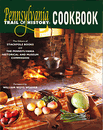Pithole Oysters
This article originally appeared in Pennsylvania Trail of History Cookbook
Like chicken wings today, in the nineteenth century, oysters were wildly popular. Oysters were cheap and plentiful, and every town in areas where they could be shipped inland had oyster parlors, oyster cellars, oyster saloons, oyster bars, oyster houses, oyster stalls, and oyster lunchrooms. The primary source of oysters in nineteenth-century Pennsylvania was the Chesapeake Bay, which produced 10,000,000 to 14,000,000 tons annually. There was even a recipe for mock oyster soup, made from salsify *, when the real thing was not available.
Former Civil War soldiers, who acquired a taste for canned oysters during their military service, created a demand for this delicacy in the booming oil fields of Pennsylvania. Oil wealth meant they could afford the luxury of the fresh oysters that traveled by train from Baltimore to Titusville packed in barrels of sawdust and ice. Despite the long trip from the Chesapeake and the fifteen-mile wagon trip over steep hills and heavily rutted muddy roads to Pithole, most of the oysters seem to have arrived in edible condition. Those who stepped up to the marble counters of the oyster bars consumed the raw oysters as fast as the shuckers could ready them, without bothering with a plate. Local lore was that the consumption of alcoholic beverages with the oysters killed any bacteria that might have poisoned diners.
At one time, Pennsylvania led the world in oil production. Pennsylvania's historic oil industry is chronicled at Drake Well Museum and Park in Venango County and at the site of nearby Pithole City.
Pennsylvania's oil boom began in Titusville on August 27, 1859, when Edwin L. Drake perfected a way to drill for oil and extract it from the ground. In 1865, oil was discovered at Pithole, and by September of the same year, Pithole had grown from a farming area to a city of 15,000, complete with restaurants, fifty hotels, theaters, saloons, dance halls, and even brothels. But Pithole declined almost as rapidly as it grew. The supply of oil petered out, the population shrank (by the end of 1866, it had dwindled to less than 2,000), and the hastily constructed wooden buildings gradually disappeared. Today nothing remains of this boomtown but cellar holes in a hillside meadow.
* Recipes are available in the Pennsylvania Trail of History Cookbook
Visit
Drake Well Museum and Park, Titusville, PA
Drake Well Museum and Park features operating oil field machinery and a replica of the original well house.
For Further Reading
 |
Pennsylvania Trail of History Cookbook Edited by Kyle R. Weaver, Diane B. Reed, and Fred Lauver Forward by William Woys Weaver Stackpole Books and Pennsylvania Historical and Museum Commission 2004 |
 |
Drake Well Museum and Park: Pennsylvania Trail of History Guide by Jon Sherman Stackpole Books and Pennsylvania Historical and Museum Commission 2002 |


